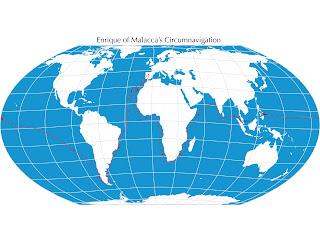 |
| Image of a ship on Borobudur bas-relief. Source. |
[Updated from 3/27/22]
Bas-relief* carvings at the Borobudur temple on Java give us a brief look into the lives of eighth-century Javanese, including the ships used in regional trade in the period.
Borobudur ships are eighth-century double outriggers depicted in bas-relief carvings at the Borobudur Buddhist temple in central Java. These are the vessels that carried the flourishing trade around Southeast Asia during the Srivijayan thalassocracy, or maritime empire, that ruled from Java between the seventh and thirteenth centuries.
First, the temple: To understand the meaning of the reliefs, it’s essential to understand the importance of Borobudur. The temple was built around 780 by the Shailendra (from Sanskrit, meaning “King of the Mountain”), a dynasty that ruled central Java beginning in the eighth century. This was the region that produced the rice and other foodstuffs that fed the merchants and trade hubs of the Srivijayan empire.
Borobudur is the largest Buddhist monument ever built and the largest monument of any sort in the Southern Hemisphere. This unique holy mountain was designed to serve the living, to illustrate the path from greed and desire to enlightenment. And while the religion was an import from India, the temple is clearly a Javanese monument built for the Javanese people, with numerous features added by the Shailendra—for instance, its being a holy mountain, in maritime Southeast Asia, where mountains were seen as centers of power and spiritual forces.
Borobudur is a UNESCO World Heritage Site.
 |
| Painting by G.B. Hooijer (c. 1916–1919). Source. |
Carvings at Borobudur offer glimpses on life on Java at the time, from palace life to people in villages, to, importantly, the Borobudur ships.
In 1982, a British sailor named Philip Beale led a team of Indonesian shipbuilders to reconstruct a replica Borobudur ship and sail it from Jakarta to Madagascar and then around the Cape of Good Hope. Also supervising the work was Nick Burningham, an expert on Indonesian watercraft.
(Beale later built a replica Phoenician galley, which he sailed round Africa, and then from Morocco to the Caribbean.)
They named the Borobudur ship Samudra Raksa (Defender of the Seas). The expedition took place over six months between August 2003 and February 2004, retracing the historical cinnamon shipping route.
Today the Samudra Raksa is on display at the Samudra Raksa Museum, just north of the Borobudur Temple.
 |
| Replica at Samudra Raksa Museum. Source. |
Single and double outrigger canoes were likely the vessels that seafaring Austronesians used in the earliest ocean crossings, ranging from Southeast Asia to Madagascar to the west, and to Hawaii and Easter Island to the east.
 |
| A replica Borobudur ship, Resorts World Sentosa, Singapore. Source. |
• Plate renderings: By Haddon, A.C. - Haddon, A.C. (1920). The Outriggers of Indonesian Canoes. London, Royal Anthropological Institute of Great Britain and Ireland., Public Domain, https://commons.wikimedia.org/w/index.php?curid=70260900
Enrique of Malacca Completes First Circumnavigation—by Language
.

.png)
.png)
.png)
.png)
.png)
